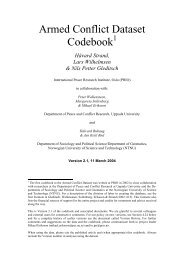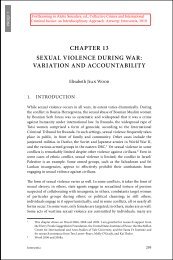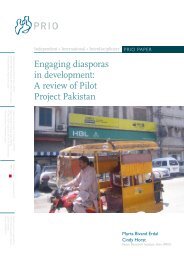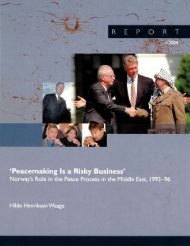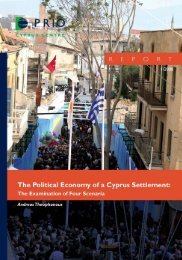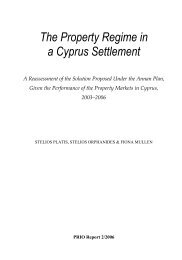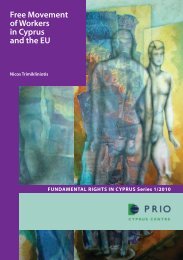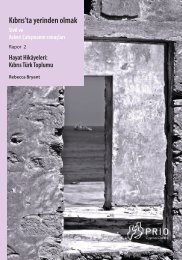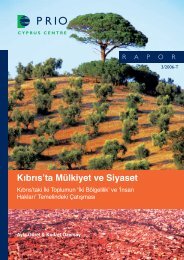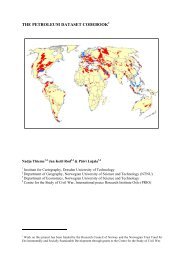ecently developed. The approaches <strong>to</strong> impact assessment developed by NPA include consultationswith community and other non-HMA implementers. The government is seen as a further key <strong>to</strong> theprocess. NPA Angola has tried <strong>to</strong> relate constructively with local government, INAROEE and theMinistry of Social Affairs and Reintegration (MINARS), both in information exchange and in providingthe government with seconded personnel. Despite this, the Angolan government has pressuredNPA <strong>to</strong> undertake tasks for political reasons. In the past, NPA believed that if it wanted <strong>to</strong> continueworking in Angola, it had <strong>to</strong> respond <strong>to</strong> requests from regional politicians irrespective of the predictedimpact of the task, whenever such requests were presented. Currently, this is changing with the developmen<strong>to</strong>f the impact-assessment methodology. The establishment of a standard approach is fundamentalin preventing this from occurring in the future, because impact assessments can be used <strong>to</strong>establish a common language between NPA and government officials. The government will have <strong>to</strong>realize that NPA is restricted, both by impact-assessment prerequisites and on the types of tasks theycan undertake.The government channelIn general, there have been few studies on the use of the government and the military as implementersof mine action, and very little, if anything, is known about their efficacy. In Nicaragua, the governmenthas assumed responsibility for virtually all aspects of mine action in the country. This includes thesetting of priorities, the general coordination of HMA and HMA implementation. In the followingsections, we assess the Nicaraguan military as implementers of mine action in Nicaragua.Sida’s roleBeginning in 1996, Sida has provided support for demining in Nicaragua through the OAS. Aside fromsupporting mine clearance, Sida has also channelled funds through the OAS for limited work on victimassistance. In terms of mine clearance, Sida has not been directly involved in demining efforts. However,Sida has requested that specific areas be demined in order <strong>to</strong> facilitate other Sida-funded developmentprojects. Sida has thus far refrained from moni<strong>to</strong>ring the work conducted by either the armedforces or the government. One reason for this has been that Sida is understaffed at the field level.A second reason is that Sida staff do not have the expertise required <strong>to</strong> moni<strong>to</strong>r and assess. From theperspective of the OAS, this is advantageous in that it places fewer restrictions on implementingorganizations. Sida did propose that Honduran and Nicaraguan demining efforts be more closelycoordinated, but this was rejected by the OAS owing <strong>to</strong> the complexity and difficulty of such an arrangement,along with the different priorities inherent in each country. 19Assessment of the Government programme in NicaraguaRelevanceThe mine problem in Nicaragua – as well as the rest of Latin America – has never reached the proportionsof other countries examined in this report. Damage <strong>to</strong> infrastructure in Nicaragua has beenconsiderably less than in other cases, and the overall level of post-conflict infrastructure reconstructionin the form of roads and bridges is not as immediate. Furthermore, the number of victims from landminesis relatively low, and the issue of refugee return has not been linked <strong>to</strong> the mine problem. 2019Perina, Dr Ruben M. (OAS) & Mr William McDonough (OAS), 1997. Correspondence <strong>to</strong> Ms Elisabeth Lewin, LatinAmerica Department, Sida, 22 July20Landmines in Nicaragua claim upwards of 80 victims per year, and <strong>to</strong> date a <strong>to</strong>tal of 553 persons have been reportedvictims of landmine accidents. Centro de Estudios Internacionales CEI [International Studies Centre], 1999. MinasAntipersonales y Desminado en Nicaragua: Avances y Limitaciones [Anti-personnel <strong>Mine</strong>s and Demining in Nicaragua: Advances andLimitations]. Nicaragua: CEI, p.15.34 Sida’s CONTRIBUTION TO HUMANITARIAN MINE ACTION – Sida EVALUATION 01/06
Among the most mined areas are agricultural lands in the northern portion of Nicaragua, and theareas bordering Costa Rica. Although the mine problem in Nicaragua is relatively limited, the abovefac<strong>to</strong>rs nevertheless dictate a need for mine action in Nicaragua. However, the landmine problem inNicaragua has been largely neglected: it was not delineated in the peace process as an essential componen<strong>to</strong>f reconstruction, nor was it part of the political agenda of either the Chamorro regime or theSandinistas.Prior <strong>to</strong> the Ottawa process, there was little interest in HMA in Latin America. The initial deminingeffort in Nicaragua was ad hoc and piecemeal. In 1993, the Organization of American States (OAS)initiated its support <strong>to</strong> the programme, but the programme ended prematurely as a result of lack offunds. Although demining was resumed in 1995, it was not until the aftermath of Hurricane Mitchthat HMA was addressed in a more comprehensive manner. The destruction left by Mitch focused theattention of the international aid community on Nicaragua. From the perspective of mine action, itallowed the Nicaraguan government <strong>to</strong> rethink its strategy for HMA. The end result was the creationof the National Commission for Demining (CND). This new approach <strong>to</strong> HMA is viewed as moreholistic and integrated. The extent <strong>to</strong> which this is true is an issue we will return <strong>to</strong> in latter sections ofthis chapter. Current estimates indicate that the mine threat can be adequately dealt with by the year2004. Such an estimate presumes that the programme is able <strong>to</strong> secure the funding needed <strong>to</strong> maintainits current pace.In Nicaragua, the use of the military is widely regarded as the best approach <strong>to</strong> demining for severalreasons. This is not necessarily because other options are not available. For instance, NGOs could be aviable alternative in the Nicaraguan context. However, the Nicaraguan government and military feelsthat the issue of landmines is a national problem that can effectively be dealt with by national institutionsand organizations. Hence, there is consensus that there is no immediate need for NGO involvement.Unlike the case in many other countries, the Nicaraguan military has the necessary expertise,legitimacy and professionalism needed <strong>to</strong> address the mine problem. Last but not least, the military hasassumed responsibility for HMA because they laid the majority of the mines.The Nicaraguan programme has two innovative components of note. First, a special pla<strong>to</strong>on, whichis currently undergoing training, will be in charge of spot demining, marking and the destruction ofs<strong>to</strong>ckpiles. Part of the rationale for the creation of the special pla<strong>to</strong>on has been the demand for acapacity that can respond <strong>to</strong> the need for spot demining. Previously, spot demining on one of the frontsmeant halting the entire operation. Second, the military has initiated the employment of a psychologist<strong>to</strong> provide counselling and support for the deminers.ImpactThe need for technical surveys outlining the extent and location of minefields is essential for anydemining program. However, in the Nicaraguan context, this has been somewhat less important owing<strong>to</strong> the availability of existing maps. Although Hurricane Mitch caused a lot a damage, it did not doenough <strong>to</strong> render these maps completely irrelevant. According <strong>to</strong> the military, Hurricane Mitch affectedareas that had <strong>to</strong> be surveyed, but the process was not <strong>to</strong>o time consuming. The military identified64 suspected mined areas in the post-Mitch phase by conducting interviews with local populations. Thenumber of mines laid by the Contras is relatively limited. In order <strong>to</strong> establish the scope of Contra-laidmines, the military has relied primarily on the input of local populations. The original maps <strong>to</strong>getherwith the post-Mitch data and the information gathered in the areas mined by the Contras providesample information on the location of the mines in Nicaragua.Sida’s CONTRIBUTION TO HUMANITARIAN MINE ACTION – Sida EVALUATION 01/06 35
- Page 4: This report is part of Sida Evaluat
- Page 9 and 10: MDDMEDDSMGMMLSWMoPHMOUMPLANATONDING
- Page 12 and 13: the conclusions of this report is t
- Page 14 and 15: A prime concern with Mine Action Ce
- Page 16 and 17: 3. The coordination of mine action,
- Page 18 and 19: an needs and the needs of victims o
- Page 20 and 21: At the same time as Sida has been o
- Page 22 and 23: er, throughout the data collection,
- Page 24 and 25: Donors may feel that the costs of i
- Page 26 and 27: is genuinely new. 8 At an overall l
- Page 28 and 29: The first attempt to apply a form o
- Page 30 and 31: standard for basic impact surveys.
- Page 32 and 33: Community studiesCommunity studies
- Page 34 and 35: and progress monitored in all phase
- Page 36 and 37: 3 Implementation ChannelsOver the p
- Page 38 and 39: cal implementation and management,
- Page 40 and 41: ing that demining has any effect at
- Page 42 and 43: actual response. In an effort to ov
- Page 46 and 47: A different tool that will be used
- Page 48 and 49: Alternative implementation channels
- Page 50 and 51: appear to have been doing a good jo
- Page 52 and 53: Coordination may at times even be c
- Page 54 and 55: itarian and development effort. Imp
- Page 56 and 57: Two). In terms of coordinating mine
- Page 58 and 59: ased demining of AREA. Another type
- Page 60 and 61: The Kosovo UNMACC took a number of
- Page 62 and 63: would be accredited and tasked by U
- Page 64 and 65: programme. The proposal was backed
- Page 66 and 67: The present landscape of Swedish ac
- Page 68 and 69: demining purposes. Buoyed by a wave
- Page 70 and 71: given that SRSA also recruits perso
- Page 72 and 73: teams. The need for a breeding capa
- Page 74 and 75: 6 RecommendationsIn the preceding c
- Page 76 and 77: • MACs should operate with agreem
- Page 78 and 79: 7 ConclusionIn this report, we have
- Page 80: 70Appendix 1
- Page 89 and 90: Ziauddin Operations Officer METADup
- Page 91 and 92: Bennedich, Claes Department for eva
- Page 93 and 94: Appendix 3BIBLIOGRAPHYAccelerated D
- Page 95 and 96:
Faulkner, F. & L Pettiford, 1998.
- Page 97 and 98:
McGrath, Rae, 2000. Landmines and U
- Page 99 and 100:
Miscellaneous DocumentsBrady, Justi
- Page 101 and 102:
Appendix 4Sida’s CONTRIBUTION TO
- Page 103 and 104:
Appendix 6• The area must be secu
- Page 105 and 106:
Appendix 7Locality identifier: Dist
- Page 107:
Recent Sida Evaluations00/37:1 Asse



